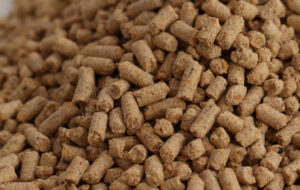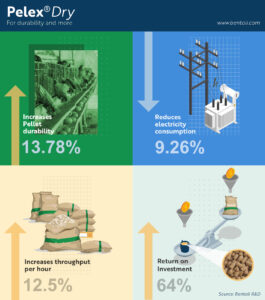
It is now well established that pellet durability pays. We have covered this topic well in the past highlighting scientific research papers that show improvement in animal performance when coarse mash is replaced by pelleted feed or the durability of pelleted feed is improved. Since our previous blog, additional research results have become available, for instance, the work by Lemons & coworkers published in the Journal of Applied Poultry Research in 2019 showing that performance of broilers can be enhanced by increasing the particle size of the starter feeds.
The most efficient way to improve pellet durability is by adding a pellet binder such as Bentoli’s Pelex® Dry. We have found that Pelex® Dry not only improves pellet durability and reduces fine generation during crumbling, transportation and feeding, but also provides numerous benefits during the pelleting process.
A recent trial with one of our customers in India showed that the benefits are quite consistent and provide a handsome return on investment on the product’s use in feed mills. The trials were conducted in a pellet mill producing broiler finisher feeds. The pellet mill had a rated capacity 5 tons per hour but was operating at 3.4 tons per hour. Adding Pelex® Dry at 1 kg/ton restored the capacity to 5.2 tons per hour. Inclusion of the binder also improved pellet durability by 13.78%, reduction in electricity consumption per ton by 9.26% and throughput improvement by 12.5%. The savings in electricity consumption, additional feed production per shift, increased die life returned around 64% of the investment made on the inclusion of Pelex® Dry.

While the extent of benefits will vary based on feed formulation, the equipment and process set up, physical condition and age of the pellet mill, the benefits while pellet binder is included in the feed are too obvious not to ignore or take advantage after proper trials are conducted.

